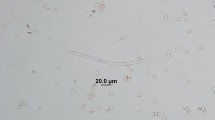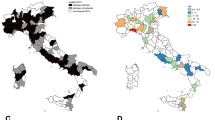Abstract
Filarioids of the genus Cercopithifilaria (Spirurida, Onchocercidae) are parasites of wild and domestic animals in tropical and subtropical regions being transmitted by ixodid ticks. Though this filarioid species have been studied in canine and tick populations in Europe, data on their species diversity and geographical distribution in Greece is scant. Thus, the aims of this study were to investigate the presence of Cercopithifilaria spp. in dogs and ticks across Greece and to assess the possible risk factors. A total of 500 skin biopsies were collected from dogs, while 508 ticks were collected from 180 infested animals and examined. Sediments from skin biopsies were microscopically screened for detection of dermal microfilaria (mfs). Skin samples (n = 115) and tick specimens (n = 153) were molecularly subjected by PCR. Overall, 70 samples (14%) scored positive for mfs. Specifically, 68 samples (13.6%) were positive for Cercopithifilaria bainae and two (0.4%) were co-infected with C. bainae and Cercopithifilaria sp. II. Molecular analyses revealed that all sequences obtained belong to C. bainae. Haplotype I was the most frequent (92.6%), followed by haplotype XVIII (3%) and haplotypes II and IX (1.5%). Three new haplotypes of C. bainae, named XIX, XX, and XXI, were also identified. Among the risk factors examined, habitat, dog use, body weight, tick infestation history, and the use of acaricides were associated with the presence of C. bainae. The estimated prevalence of Cercopithifilaria spp. demonstrates that these filarioids are common in dogs and ticks in Greece. Finally, the identification of 7 haplotypes for C. bainae confirms their genetic variability.




Similar content being viewed by others
Data availability
The datasets generated during and analyzed during the current study are available from the corresponding author on reasonable request.
References
Andersson MO, Chitimia-Dobler L (2017) Detection of Cercopithifilaria bainae in western Romania. Parasitol Res 116:3235–3238. https://doi.org/10.1007/s00436-017-5625-5
Angelou A, Gelasakis AI, Verde N, Pantchev N, Schaper R, Chandrashekar R, Papadopoulos E (2019) Prevalence and risk factors for selected canine vector-borne diseases in Greece. Parasit Vectors 12:283. https://doi.org/10.1186/s13071-019-3543-3
Bain O, Baker M, Chabaud AG (1982) Nouvelles données sur la lignée Dipetalonema (Filarioidea, Nematoda). Ann Parasitol Hum Comp 57:593–620
Bain O, Uni S, Takaoka H (2002) A synthetic look at a twenty years old taxon. Cercopithifilaria its probable evolution, Proceedings of the 10th International 5, 194, Congress of Parasitology-ICOPA X, Vancouver (Canada) 4–9 August, Monduzzi Editore:365–368
Boyd M, Santoro D, Craft WF, Ginn PE, Childress AL, Wellehan JFX, Walden HS (2019) Dermatitis caused by autochthonous Cercopithifilaria bainae from a dog in Florida, USA: clinical, histological and parasitological diagnosis and treatment. Vet Dermatol 30:68–e20. https://doi.org/10.1111/vde.12701
Brianti E, Otranto D, Dantas-Torres F, Weigl S, Latrofa MS, Gaglio G, Napoli E, Brucato G, Cauquil L, Giannetto S, Bain O (2012) Rhipicephalus sanguineus (Ixodida, Ixodidae) as intermediate host of a canine neglected filarial species with dermal microfilariae. Vet Parasitol 183:330–337. https://doi.org/10.1016/j.vetpar.2011.07.031
Cortes HC, Cardoso L, Giannelli A, Latrofa MS, Dantas-Torres F, Otranto D (2014) Diversity of Cercopithifilaria species in dogs from Portugal. Parasit Vectors 7:261. https://doi.org/10.1186/1756-3305-7-261
Estrada-Pena A, Michalca AD, Petney TN (2017) Ticks of Europe and North Africa (a guide to species identification). Springer International Publishing Switzerland, Cham
Ferri E, Barbuto M, Bain O, Galimberti A, Uni S, Guerrero R, Ferte H, Bandi C, Martin C, Casiraghi M (2009) Integrated taxonomy: traditional approach and DNA barcoding for the identification of filarioid worms and related parasites (Nematoda). Front Zool 6:1. https://doi.org/10.1186/1742-9994-6-1
Gabrielli S, Giannelli A, Brianti E, Dantas-Torres F, Bufalini M, Fraulo M, La Torre F, Ramos RAN, Cantacessi C, Latrofa MS, Cancrini G, Otranto D (2014) Chronic polyarthritis associated to Cercopithifilaria bainae infection in a dog. Vet Parasitol 205:401–404. https://doi.org/10.1016/j.vetpar.2014.06.027
Ionica AM, D’Amico G, Mitkova B, Kalmar Z, Annoscia G, Otranto D, Modry D, Mihalca AD (2014) First report of Cercopithifilaria spp. in dogs from Eastern Europe with an overview of their geographic distribution in Europe. Parasitol Res 113:2761–2764. https://doi.org/10.1007/s00436-014-3931-8
Kearse M, Moir R, Wilson A, Stones-Havas S, Cheung M, Sturrock S, Buxton S, Cooper A, Markowitz S, Duran C, Thierer T, Ashton B, Meintjes P, Drummond A (2012) Geneious Basic: an integrated and extendable desktop software platform for the organization and analysis of sequence data. Bioinformatics 28:1647–1649. https://doi.org/10.1093/bioinformatics/bts199
Latrofa MS, Angelou A, Giannelli A, Annoscia G, Ravagnan S, Dantas-Torres F, Capelli G, Halos L, Beugnet F, Papadopoulos E, Otranto D (2017) Ticks and associated pathogens in dogs from Greece. Parasit Vectors 10:301. https://doi.org/10.1186/s13071-017-2225-2
Maia C, Casero M, Annoscia G, Latrofa MS, Colella V, Pereira A, Azevedo F, Otranto D (2017) Cercopithifilaria sp. II in Vulpes vulpes: new host affiliation for an enigmatic canine filarioid. Parasitol Res 116:441–443. https://doi.org/10.1007/s00436-016-5308-7
Malacrida F, Hegglin D, Bacciarini L, Otranto D, Nageli F, Nageli C, Bernasconi C, Scheu U, Balli A, Marenco M, Togni L, Deplazes P, Schnyder M (2008) Emergence of canine ocular thelaziosis caused by Thelazia callipaeda in southern Switzerland. Vet Parasitol 157:321–327. https://doi.org/10.1016/j.vetpar.2008.07.029
Miro G, Montoya A, Hernandez L, Dado D, Vazquez MV, Benito M, Villagrasa M, Brianti E, Otranto D (2011) Thelazia callipaeda: infection in dogs: a new parasite for Spain. Parasit Vectors 4:148. https://doi.org/10.1186/1756-3305-4-148
Nei M, Kumar S (2000) Molecular evolution and phylogenetics. Oxford University Press, New York
Ntais P, Sifaki-Pistola D, Christodoulou V, Messaritakis I, Pratlong F, Poupalos G, Antoniou M (2013) Leishmaniases in Greece. Am J Trop Med Hyg 89:906–915. https://doi.org/10.4269/ajtmh.13-0070
Orihel TC, Eberhard ML (1998) Zoonotic filariasis. Clin Microbiol Rev 11:366–381
Otranto D, Eberhard ML (2011) Zoonotic helminths affecting the human eye. Parasit Vectors 4:41. https://doi.org/10.1186/1756-3305-4-41
Otranto D, Testini G, De Luca F, Hu M, Shamsi S, Gasser RB (2005) Analysis of genetic variability within Thelazia callipaeda (Nematoda: Thelazioidea) from Europe and Asia by sequencing and mutation scanning of the mitochondrial cytochrome c oxidase subunit 1 gene. Mol Cell Probes 19:306–313. https://doi.org/10.1016/j.mcp.2005.05.001
Otranto D, Brianti E, Dantas-Torres F, Weigl S, Latrofa MS, Gaglio G, Cauquil L, Giannetto S, Bain O (2011) Morphological and molecular data on the dermal microfilariae of a species of Cercopithifilaria from a dog in Sicily. Vet Parasitol 182:221–229. https://doi.org/10.1016/j.vetpar.2011.05.043
Otranto D, Brianti E, Abramo F, Gaglio G, Napoli E, Latrofa MS, Ramos RA, Dantas-Torres F, Bain O (2012a) Cutaneous distribution and localization of Cercopithifilaria sp. microfilariae in dogs. Vet Parasitol 190:143–150. https://doi.org/10.1016/j.vetpar.2012.05.016
Otranto D, Brianti E, Latrofa MS, Annoscia G, Weigl S, Lia RP, Gaglio G, Napoli E, Giannetto S, Papadopoulos E, Miro G, Dantas-Torres F, Bain O (2012b) On a Cercopithifilaria sp. transmitted by Rhipicephalus sanguineus: a neglected, but widespread filarioid of dogs. Parasit Vectors 5:1. https://doi.org/10.1186/1756-3305-5-1
Otranto D, Latrofa MS, Brianti E, Annoscia G, Parisi A, Dantas-Torres F, Bain O, Gasser RB (2012c) An assessment of genetic variability in the mitochondrial cytochrome c oxidase subunit 1 gene of Cercopithifilaria sp. (Spirurida, Onchocercidae) from dog and Rhipicephalus sanguineus populations. Mol Cell Probes 26:81–89. https://doi.org/10.1016/j.mcp.2011.12.002
Otranto D, Brianti E, Dantas-Torres F, Miro G, Latrofa MS, Mutafchiev Y, Bain O (2013a) Species diversity of dermal microfilariae of the genus Cercopithifilaria infesting dogs in the Mediterranean region. Parasitology 140:99–108. https://doi.org/10.1017/S0031182012001357
Otranto D, Varcasia A, Solinas C, Scala A, Brianti E, Dantas-Torres F, Annoscia G, Martin C, Mutafchiev Y, Bain O (2013b) Redescription of Cercopithifilaria bainae Almeida & Vicente, 1984 (Spirurida, Onchocercidae) from a dog in Sardinia, Italy. Parasit Vectors 6:132. https://doi.org/10.1186/1756-3305-6-132
Ramos RA, Giannelli A, Brianti E, Annoscia G, Cantacessi C, Dantas-Torres F, Otranto D (2013) Tick vectors of Cercopithifilaria bainae in dogs: Rhipicephalus sanguineus sensu lato versus Ixodes ricinus. Parasitol Res 112:3013–3017. https://doi.org/10.1007/s00436-013-3474-4
Santos MAB, de Souza IB, de Macedo LO, do Nascimento Ramos CA, de Oliveira Rego AG, Alves LC, RAN R, de Carvalho GA (2017) Cercopithifilaria bainae in Rhipicephalus sanguineus sensu lato ticks from dogs in Brazil. Ticks Tick Borne Dis 8:623–625. https://doi.org/10.1016/j.ttbdis.2017.04.007
Santos MAB, Macedo LO, Otranto D, Ramos C, Rego A, Giannelli A, Alves LC, Carvalho GA, Ramos RAN (2018) Screening of Cercopithifilaria bainae and Hepatozoon canis in ticks collected from dogs of northeastern Brazil. Acta Parasitol 63:605–608. https://doi.org/10.1515/ap-2018-0069
Soares RL, Silva AOD, Coelho ML, Echeverria JT, Souza ML, Babo-Terra VJ, Pasquatti TN, Ramos RAN, Ramos C (2020) Molecular detection of Cercopithifilaria bainae and other tick-borne pathogens in Rhipicephalus sanguineus s.l. isolated from dogs in Midwest Brazil. Rev Bras Parasitol Vet 29:e018019. https://doi.org/10.1590/S1984-29612019109
Solinas C, Varcasia A, Brianti E, Giannetto S, Pipia AP, Columbano N, Tosciri G, Dantas-Torres F, Garippa G, Otranto D, Scala A (2014) Cercopithifilaria spp. in dogs in Sardinia Island (Italy). Parasitol Res 113:675–679. https://doi.org/10.1007/s00436-013-3695-6
Tamura K, Stecher G, Peterson D, Filipski A, Kumar S (2013) MEGA6: molecular evolutionary genetics analysis version 6.0. Mol Biol Evol 30:2725–2729. https://doi.org/10.1093/molbev/mst197
Walker JB, Keirans JE, Horak IG (2000) Genus Rhipicephalus (Acari, Ixodidae). A guide to the brown ticks of the world. Cambridge University Press, Cambridge
Funding
This study was part of the doctoral dissertation of AA., which was financially supported by the State Scholarships Foundation (ΙΚΥ).
Author information
Authors and Affiliations
Contributions
All authors read and approved the final submitted version of the manuscript. Study design, sampling, parasitological and molecular methods, and preparation of the manuscript by Athanasios Angelou; study design, molecular methods, phylogenetic analysis, preparation, and critical review of the manuscript by Maria Stefania Latrofa; molecular methods by Giada Annoscia; study design and critical review of the manuscript by Isaia Symeonidou; statistical analysis and critical review of the manuscript by Alexandros Theodoridis; study design and critical review of the manuscript by Zoe S. Polizopoulou, Domenico Otranto, and Elias Papadopoulos.
Corresponding author
Ethics declarations
Conflict of interest
The authors declare that they have no conflict of interest.
Ethics approval and consent to participate
The study was conducted in compliance with the national animal welfare regulations. The applied diagnostic veterinary procedures are not within the context of relevant EU legislation for animal experimentations (Directive 86/609/EC) and may be performed in order to diagnose animal diseases and improve animal welfare. No suffering was caused during sample collection. Consent was ensured by owners or registered veterinarians (private, public, or municipality, depending per case).
Additional information
Handling Editor: Julia Walochnik
Publisher’s note
Springer Nature remains neutral with regard to jurisdictional claims in published maps and institutional affiliations.
Electronic supplementary material
ESM 1
(DOCX 22 kb)
Rights and permissions
About this article
Cite this article
Angelou, A., Latrofa, M.S., Annoscia, G. et al. Cercopithifilaria species in dogs and ticks from Greece. Parasitol Res 119, 3391–3400 (2020). https://doi.org/10.1007/s00436-020-06784-3
Received:
Accepted:
Published:
Issue Date:
DOI: https://doi.org/10.1007/s00436-020-06784-3




